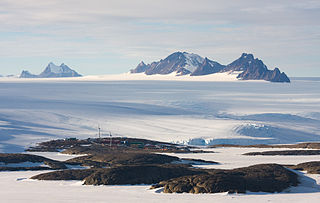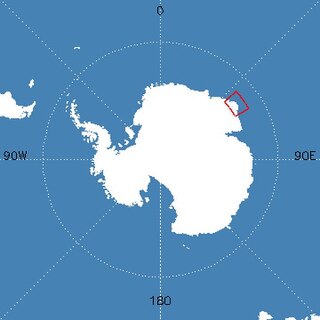Related Research Articles

Mawson Station, commonly called Mawson, is one of three permanent bases and research outposts in Antarctica managed by the Australian Antarctic Division (AAD). Mawson lies in Holme Bay in Mac. Robertson Land, East Antarctica in the Australian Antarctic Territory, a territory claimed by Australia. Established in 1954, Mawson is Australia's oldest Antarctic station and the oldest continuously inhabited Antarctic station south of the Antarctic Circle. It houses approximately 20 personnel over winter and up to 53 in summer.
The Anare Mountains are a large group of mainly snow-covered peaks and ridges along the northern coast of Victoria Land, Antarctica. The group is bounded on the north and east by the Pacific Ocean, on the west by Lillie Glacier, and on the south by Ebbe Glacier and Dennistoun Glacier. They are north of the Concord Mountains and east of the Bowers Mountains.

Lambert Glacier is a major glacier in East Antarctica. At about 80 km (50 mi) wide, over 400 km (250 mi) long, and about 2,500 m (8,200 ft) deep, it is the world's largest glacier. It drains 8% of the Antarctic ice sheet to the east and south of the Prince Charles Mountains and flows northward to the Amery Ice Shelf. It flows in part of Lambert Graben and exits the continent at Prydz Bay.

The Prince Charles Mountains are a major group of mountains in Mac. Robertson Land in Antarctica, including the Athos Range, the Porthos Range, and the Aramis Range. The highest peak is Mount Menzies, with a height of 3,228 m (10,591 ft). Other prominent peaks are Mount Izabelle and Mount Stinear. These mountains, together with other scattered peaks, form an arc about 420 km (260 mi) long, extending from the vicinity of Mount Starlight in the north to Goodspeed Nunataks in the south.
The Scott Mountains are a large number of isolated peaks lying south of Amundsen Bay in Enderby Land of East Antarctica, Antarctica. Discovered on 13 January 1930 by the British Australian New Zealand Antarctic Research Expedition (BANZARE) under Sir Douglas Mawson. He named the feature Scott Range after Captain Robert Falcon Scott, Royal Navy. The term mountains is considered more appropriate because of the isolation of its individual features.
Young Peak is a low peak near the Antarctic coast, standing just south of Holder Peak and 2 miles (3.2 km) east of Mount Caroline Mikkelsen. First plotted from air photos taken by the Lars Christensen Expedition, 1936–37, and with Holder Peak called "Tvillingfjell" by Norwegian cartographers. This peak was named by Antarctic Names Committee of Australia (ANCA) for W. Young, officer in charge at Davis Station, 1963, who led an ANARE party that surveyed this area.

Mount Elkins, also known as Jökelen is a dark, steep-sided mountain with three major peaks, the highest 2,300 meters (7,500 ft) above sea level, in the Napier Mountains of Enderby Land. Enderby Land is part of East Antarctica and is claimed by Australia as part of the Australian Antarctic Territory. The mountain was named after Terence James Elkins, an ionospheric physicist with the Australian National Antarctic Research Expeditions at Mawson Station in 1960.
The Porthos Range is the second range south in the Prince Charles Mountains of Antarctica, extending for about 30 miles in an east-to-west direction between Scylla Glacier and Charybdis Glacier. First visited in December 1956 by the Australian National Antarctic Research Expeditions (ANARE) southern party under W.G. Bewsher (1956-57) and named after Porthos, a character in Alexandre Dumas, père's novel The Three Musketeers, the most popular book read on the southern journey.

Armstrong Peak is a peak, 1,470 metres (4,820 ft) high, standing 15 nautical miles (28 km) southeast of Mount Codrington in Enderby Land of East Antarctica.

The Wilkinson Peaks, also known as Langnabbane, is a group of peaks in the Napier Mountains standing 8 kilometres (5.0 mi) southeast of Mount Griffiths and 8 kilometres (5.0 mi) northeast of Mount Elkins in Enderby Land.
Chapman Ridge is a ridge rising to 300 metres (1,000 ft) and extending southwest for 3 nautical miles (6 km) from Byrd Head. It was discovered by the British Australian New Zealand Antarctic Research Expedition, 1929–31, under Douglas Mawson, and mapped by Norwegian cartographers from aerial photographs taken by the Lars Christensen Expedition, 1936–37. It was named by the Antarctic Names Committee of Australia for the then-Australian scientist, Philip K. Chapman, auroral physicist at Mawson Station, during the International Geophysical Year, 1958. Chapman and Henry Fischer, a Swiss national, were members of the Australian National Antarctic Research Expedition (ANARE). They were the first humans to climb the ridge which they did several times. They did not take geological samples, make claims nor leave any marker.
Vukovich Peaks are two well-defined peaks surmounting the northernmost rock outcrop in the Grove Mountains. Mapped from air photos, 1956–60, by ANARE. Named by Antarctic Names Committee of Australia (ANCA) for J.N. Vukovich, weather observer at Mawson Station, 1963.
Cowell Island is a small island, partly contained by the Flatnes Ice Tongue, on the Ingrid Christensen Coast of Princess Elizabeth Land, Antarctica. It lies 6 kilometres (3 nmi) west-south-west of Hovde Island and Amanda Bay. It was first mapped from aerial photographs by the Lars Christensen Expedition, 1936–37, and first visited by an Australian National Antarctic Research Expeditions (ANARE) survey party led by M.J. Corry in February 1969. It was named by the Antarctic Names Committee of Australia for W.D. Cowell, a cook at Mawson Station in 1969 and a member of the ANARE Prince Charles Mountains survey party in the same year.
Strover Peak is a low rock peak along the coast of Antarctica, standing 6 nautical miles (11 km) west-northwest of Mount Caroline Mikkelsen. Mapped by Norwegian cartographers from air photos taken by the Lars Christensen Expedition, 1936–37, and named "Svartmulen". Renamed by Antarctic Names Committee of Australia (ANCA) for W.G.H. Strover, radio supervisor at Davis Station in 1963 and a member of the ANARE party that surveyed this feature. Acceptance of Strover Peak curtails the repetitive use of "Svart" (black) in Antarctic names.
The Gowlett Peaks are a small group of isolated peaks, consisting of tall, sharp twin peaks and two close outliers, about 8 nautical miles (15 km) northeast of the Anare Nunataks in Mac. Robertson Land, Antarctica. They were sighted in November 1955 by an Australian National Antarctic Research Expeditions party led by John Béchervaise, and were named by the Antarctic Names Committee of Australia for Alan Gowlett, an engineer at Mawson Station in 1955.
Palmer Point is a rock point on the coast of Antarctica, about 2 nautical miles (3.7 km) west of Strover Peak and 8 nautical miles (15 km) west-northwest of Mount Caroline Mikkelsen. Photographed by U.S. Navy Operation Highjump, 1946–47. Visited by I.R. McLeod, geologist with the ANARE Prince Charles Mountains survey party, 1969. Named by Antarctic Names Committee of Australia (ANCA) for J. Palmer, helicopter pilot with ANARE in 1968.
Mount Parsons is a prominent pointed peak, 1,120 m, standing in the David Range, 1 nautical mile (1.9 km) south-southwest of its north extremity. Mapped by Norwegian cartographers from aerial photos taken by the Lars Christensen Expedition, 1936–37. The peak was visited in January 1956 by an ANARE party led by John Bechervaise. Named by Antarctic Names Committee of Australia (ANCA) for Neville Parsons, cosmic ray physicist at Mawson Station, 1955.
Hamilton Bluff is a rock bluff on the coast of Antarctica, about 2 nautical miles (4 km) west of Palmer Point and 10 nautical miles (19 km) west of Mount Caroline Mikkelsen. It was first mapped by Norwegian cartographers from air photos taken by the Lars Christensen Expedition, 1936–37. It was visited by I.R. McLeod, geologist with the Australian National Antarctic Research Expeditions (ANARE) Prince Charles Mountains survey party, 1969, and was named by the Antarctic Names Committee of Australia for R. Hamilton, a helicopter pilot with ANARE in 1968.
McCarthy Nunatak is a small nunatak, the top of which is almost at the same level as the surrounding ice plateau, about 5 nautical miles (9 km) southeast of Depot Peak, Mac. Robertson Land, Antarctica. It was discovered from Australian National Antarctic Research Expeditions (ANARE) aircraft in 1970, and was named by the Antarctic Names Committee of Australia after I. McCarthy, a senior weather observer at Mawson Station in 1970, and a member of the ANARE Prince Charles Mountains survey party in 1971.
Single Island is a high ice-covered island on the west side of the Amery Ice Shelf about 26 kilometres (14 nmi) south of Landon Promontory. First plotted by ANARE from air photos taken in 1956, but incorrectly shown as a promontory. Later mapped by ANARE as an island. Named by Antarctic Names Committee of Australia (ANCA) for M. Single, senior diesel mechanic at Mawson Station in 1962, a member of the ANARE field party which visited the area in December 1962.
References
- ↑ "Australian Antarctic Gazetteer". Australian Antarctic Division. Retrieved 2008-07-02.
- ↑ "Holder Peak". Geographic Names Information System . United States Geological Survey, United States Department of the Interior . Retrieved 2012-06-20.
![]() This article incorporates public domain material from "Holder Peak". Geographic Names Information System . United States Geological Survey.
This article incorporates public domain material from "Holder Peak". Geographic Names Information System . United States Geological Survey.